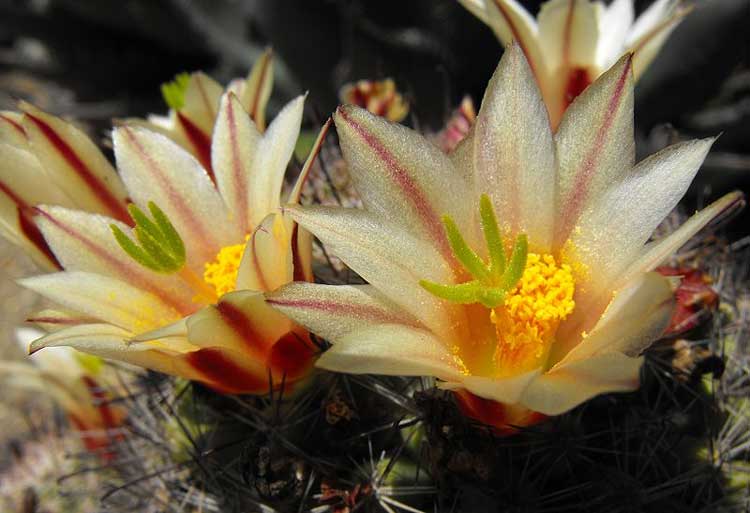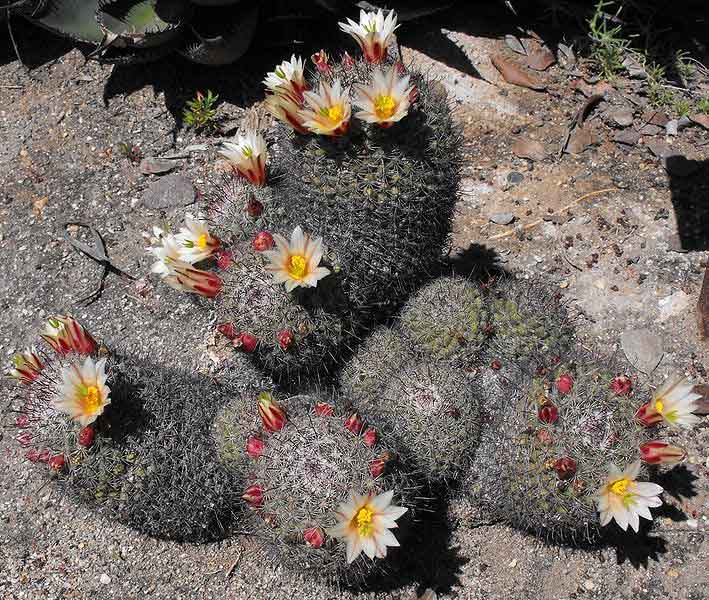
Cochemiea dioica (*)
Classification System: APG IV
Superregnum: Eukaryota
Regnum: Plantae
Cladus: Angiosperms
Cladus: Eudicots
Cladus: Core eudicots
Ordo: Caryophyllales
Familia: Cactaceae
Subfamilia: Cactoideae
Tribus: Cacteae
Genus: Cochemiea
Species: Cochemiea dioica
Name
Cochemiea dioica (K.Brandegee) Doweld, 2000
Synonyms
Mammillaria dioica K.Brandegee in Erythea 5: 115. 1897 syn. sec. ???
Neomammillaria dioica (K.Brandegee) Britton & Rose, Cactaceae 4: 115. 1923 syn. sec. ???
Ebnerella dioica (K.Brandegee) Buxb. in Oesterr. Bot. Z. 98: 89. 1951 syn. sec. ???
Chilita dioica (K.Brandegee) Buxb. in Sukkulentenkunde 5: 17. 1954 syn. sec. ???
Mammillaria dioica subsp. dioica syn. sec. ???
Mammillaria dioica var. dioica syn. sec. ???
Mammillaria goodrichii Engelm., Erythea 5: 115. 1897 syn. sec. Tropicos
Mammillaria fordii Orcutt in W. Amer. Sci. 13: 49. 1902 syn. sec. Tropicos
Chilita fordii Orcutt in Cactography 2. 1926 syn. sec. Kew WCVP (2019)
Mammillaria incerta Parish, Fl. Calif. 2: 549. 1936 syn. sec. Tropicos
Mammillaria dioica var. incerta (Parish) Munz, Aliso 4(1): 94. 1958 syn. sec. Tropicos
Mammillaria dioica f. incerta (Parish) Neutel. in Succulenta (Netherlands) 65: 119. 1986 syn. sec. Kew WCVP (2019)
Distribution
Native distribution areas:
Continental: Northern America
Regional: Southwestern USA
California
Regional: Mexico
Mexico Northeast

Cochemiea dioica
References: Brummitt, R.K. 2001. TDWG – World Geographical Scheme for Recording Plant Distributions, 2nd Edition
References
Primary references
Doweld, A.B., 2000. Sukkulenty 3: 39.
Additional references
Korotkova, N., Aquino, D., Arias, S., Eggli, U., Franck, A. , Gómez-Hinostrosa, C., Guerrero, P.C., Hernández, H.M., Kohlbecker, A., Köhler, M., Luther, K., Majure, L.C., Müller, A., Metzing, D., Nyffeler, R., Sánchez, D., Schlumpberger, B. & Berendsohn, W.G. 2021. Cactaceae at Caryophyllales. org–a dynamic online species-level taxonomic backbone for the family. Willdenowia 51(2): 251–270. DOI: 10.3372/wi.51.51208 Open access Reference page.
Links
Korotkova, N. et al. 2021. Cochemiea dioica in Cactaceae at Caryophyllales.org. A global synthesis of species diversity in the angiosperm order Caryophyllales. Published online. Accessed: 2021 Nov 13. Reference page.
International Plant Names Index. 2021. Cochemiea dioica. Published online. Accessed: Nov 13 2021.
Tropicos.org 2021. Cochemiea dioica. Missouri Botanical Garden. Published online. Accessed: 13 Nov 2021.
Hassler, M. 2021. Cochemiea dioica. World Plants: Synonymic Checklists of the Vascular Plants of the World In: Roskovh, Y., Abucay, L., Orrell, T., Nicolson, D., Bailly, N., Kirk, P., Bourgoin, T., DeWalt, R.E., Decock, W., De Wever, A., Nieukerken, E. van, Zarucchi, J. & Penev, L., eds. 2021. Species 2000 & ITIS Catalogue of Life. Published online. Accessed: 2021 Nov 13. Reference page.
Vernacular names
العربية: ضرعاء لحوية
English: greenflower nipple cactus, Greenflower Nipple Cactus
español: Biznaga de Flor Verde
Cochemiea dioica or Mammillaria dioica, also called the strawberry cactus, California fishhook cactus, strawberry pincushion or fishhook cactus, is a cactus species of the genus Mammillaria.[1] Its common name in Spanish is biznaga llavina.[2]
Distribution
The cactus is found in the western Colorado Desert scrub including in Anza-Borrego Desert State Park, and in Coastal sage scrub habitats of Southern California; and in coastal chaparral and Sonoran Desert habitats of Baja California and Baja California Sur states on the Baja California Peninsula of México.[3][4] It grows from 10–1,500 feet (3.0–457.2 m) in elevation.
Polyploid wild plants of this species have been found in Mexico. Both tetraploid and hexaploid varieties have been recorded.
Description
Mammillaria dioica possesses short, firm tubercles ending in the spines. Most of these spines are whitish and straight, but each tubercle has a longer central spine which is slightly curved and dark.[5]
A single plant can bear both male and female flowers, from mid-spring to mid-summer. Some plants may produce bisexual flowers as well, thus totaling three types of flower on a single plant. The flowers are white to cream in color and range from 10 millimeters (0.4 inch) to 30 millimeters (1.2 inches) in length.[5]
The fruits produced are bright red and ovoid, often with one end thicker than the other and are edible and tastes like a cross between a strawberry and a kiwi. The seeds are small (0.6 to 0.8 millimeters), black, and pitted.[5]
Subspecies
Recognized subspecies include:[2]
Mammillaria dioica subsp dioica
Mammillaria dioica subsp angelensis
Mammillaria dioica subsp estebanensis
Uses
The Kumeyaay people (Diegueño), of Baja California and Southern California, eat the raw fruits as a food source.[6]
Cultivation
Mammillaria dioica is cultivated by specialty cactus plant nurseries and by botanical gardens for plant sales. It requires very well-drained soil, and so is often grown in pots and in raised beds in drought tolerant gardens.[7][8]
References
Calflora: Mammillaria dioica
IUCN Red List: Mammillaria dioica
efloras.org: Mammillaria dioica distribution map
Jepson
efloras.org: Mammillaria dioica
University of Michigan, Dearborn: Native American Ethnobotany of Mammillaria dioica
Desert Tropicals.com: cultivation information and synonymy
PlantFiles.com: cultivation of Mammillaria dioica (Strawberry Cactus)
U.S. Army Field Manuals: Survival IQ Handbook
Retrieved from "http://en.wikipedia.org/"
All text is available under the terms of the GNU Free Documentation License

